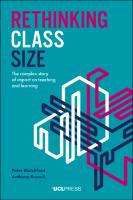Rethinking Class Size
The complex story of impact on teaching and learning
| dc.contributor.author | Blatchford, Peter | |
| dc.contributor.author | Russell, Anthony | |
| dc.date.accessioned | 2021-12-08T12:15:35Z | |
| dc.date.available | 2021-12-08T12:15:35Z | |
| dc.date.issued | 2020 | |
| dc.identifier | ONIX_20211208_9781787358799_8 | |
| dc.identifier | OCN: 1201691869 | |
| dc.identifier.uri | https://library.oapen.org/handle/20.500.12657/51776 | |
| dc.description.abstract | The debate over whether class size matters for teaching and learning is one of the most enduring, and aggressive, in education research. Teachers often insist that small classes benefit their work. But many experts argue that evidence from research shows class size has little impact on pupil outcomes, so does not matter, and this dominant view has informed policymaking internationally. Here, the lead researchers on the world’s biggest study into class size effects present a counter-argument. Through detailed analysis of the complex relations involved in the classroom they reveal the mechanisms that support teachers’ experience, and conclude that class size matters very much indeed. Drawing on 20 years of systematic classroom observations, surveys of practitioners, detailed case studies and extensive reviews of research, Peter Blatchford and Anthony Russell contend that common ways of researching the impact of class size are limited and sometimes misguided. While class size may have no direct effect on pupil outcomes, it has, they say, significant force through interconnections with classroom processes. In describing these connections, the book opens up the everyday world of the classroom and shows that the influence of class size is everywhere. It impacts on teaching, grouping practices and classroom management, the quality of peer relations, tasks given to pupils, and on the time teachers have for marking, assessments and understanding the strengths and challenges for individual pupils. From their analysis, the authors develop a new social pedagogical model of how class size influences work, and identify policy conclusions and implications for teachers and schools. ‘This book is sorely needed. It is evidence based, it is comprehensive, it is engaging, and it will add immeasurably to the debates and literature.’ John Hattie, Laureate Professor, Melbourne Graduate School of Education | |
| dc.language | English | |
| dc.subject.classification | thema EDItEUR::J Society and Social Sciences::JN Education | en_US |
| dc.subject.other | education | |
| dc.subject.other | class size | |
| dc.subject.other | learning | |
| dc.subject.other | teaching | |
| dc.subject.other | classroom processes | |
| dc.subject.other | special educational needs | |
| dc.subject.other | classroom management | |
| dc.subject.other | curriculum | |
| dc.subject.other | peer relations | |
| dc.subject.other | SEN | |
| dc.subject.other | educational policy | |
| dc.subject.other | assessment | |
| dc.title | Rethinking Class Size | |
| dc.title.alternative | The complex story of impact on teaching and learning | |
| dc.type | book | |
| oapen.identifier.doi | 10.14324/111.9781787358799 | |
| oapen.relation.isPublishedBy | df73bf94-b818-494c-a8dd-6775b0573bc2 | |
| oapen.relation.isbn | 9781787358799 | |
| oapen.relation.isbn | 9781787358805 | |
| oapen.relation.isbn | 9781787358812 | |
| oapen.relation.isbn | 9781787358829 | |
| oapen.relation.isbn | 9781787358836 | |
| oapen.imprint | UCL Press | |
| oapen.pages | 328 | |
| oapen.place.publication | London |

